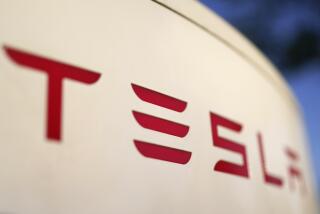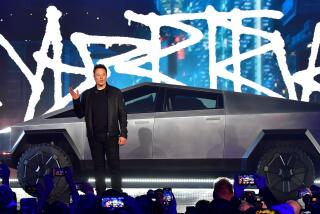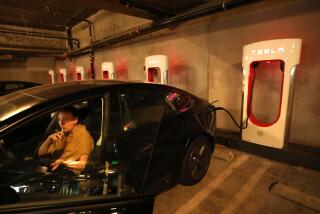Meet Taycan, Porsche’s first all-electric sports car and Tesla’s latest challenger
Porsche chose Niagara Falls to introduce its new Taycan all-electric sports car on Wednesday. The thundering water flow can turn out 2.5 million kilowatts of hydropower — a powerful source of sustainable energy and a potent symbol for a product that aspires to be nearly pollution-free.
Another, more subtle reason for the backdrop: the two statues of Nikola Tesla looking down on the festivities, one from the Canadian side, the other from the U.S. side. Niagara Falls is the site where Tesla first tested his controversial alternating current electrical distribution system in the late 19th century, so there are Tesla memorials all over the place.
The Taycan is a billion-dollar bet on an electric-drive future, the first in what the high-end German car company hopes will be a long line of battery-powered high-performance cars and sport utility vehicles. And it is perhaps the most potent challenger yet to electric-car king Tesla Inc.
First, though, the car must pass muster with Porsche’s high-end customers and their sky-high expectations. With the Taycan, the company seeks a reputation for quality and performance on par with that of internal-combustion classics such as its storied 911 series. And its reception here in California — which accounts for 25% of Porsche sales in the U.S. — will be crucial.
So far, so good — the company says more than 20,000 have been ordered, with current production plans at 40,000 cars a year. In California, customer delivery begins in December. If Porsche makes and sells 40,000 cars a year, the Taycan would top 911 sales, which hit 35,573 worldwide in 2018.
The Taycan rockets from 0 to 60 in 2.6 to 3 seconds, with a range estimated at close to 240 miles. (The Environmental Protection Agency has yet to release official U.S. government range figures.) Most readers of this article won’t be able to afford one. There are two models, with base prices at $150,000 and $185,000. (A less powerful sub-$100,000, single-motor version is rumored to be in the works.)
At those prices, the Taycan has few, if any, direct competitors. Porsche is hoping to sell most of its Taycans to buyers who’ve never bought an electric vehicle before.
If it steals sales from another electric car model, that will be the Tesla Model S, the four-door luxury electric sedan that put Tesla on the map in 2012. The S took the world by storm, but it hasn’t been given a major body refresh in seven years and no longer is the hot new thing. Model S sales topped out in the last quarter of 2018 and have declined since then as attention as shifted to the less-expensive Model 3. (Its performance is regularly enhanced with over-the-air updates and occasional mechanical improvements.)
Still, the top, Performance version of the Model S outperforms the Taycan in range (345 miles) and a 0-to-60 time (2.4 seconds), at a cost of $100,000 to $120,000.
Porsche executives believe that performance-oriented drivers interested in going electric will gravitate to the Taycan because of the famed track-worthy driving dynamics the company has been perfecting since Ferdinand Porsche began building race cars in the 1920s. Stefan Weckbach, the company’s vice president for electric-drive cars, is so confident that the Taycan holds a unique position in the marketplace that he calls it “the world’s first fully electric sports car.” (Tesla fans would counter that the company’s first vehicle, a small Lotus body attached to a Tesla battery drivetrain called the Roadster, was the world’s first.)
There’s the latest hot new toy factor to consider too.
“I really think Mr. Musk did a fine job of showing the [big auto companies] that this electric thing could happen,” said Danny McKenna, owner of McKenna Porsche in Norwalk. “People wanted that Tesla parked in their driveway. Now, they’ll want that Porsche parked there.”
Outsiders will test those assumptions. Car & Driver, Road & Track, Motor Trend and the rest of the car enthusiast magazines will be putting the Taycan up against the Model S and a number of other performance cars, both electric and liquid-fuel, to see whether the electric Taycan truly possesses what the company calls “Porsche DNA.” (This writer, after a high G-force passenger seat ride with a professional driver around Porsche’s Atlanta test track, predicts thumbs up from reviewers across the board.)
Long-term, customer demand for the car will tell the tale.
The market for expensive performance sports cars is tiny: 0.1% of cars sold in the U.S., according to Edmunds. So even if buyers love it, and 40,000 are sold around the world every year, the Taycan will serve Porsche as an image leader, not a massive profit generator. Porsche now makes most of its money with the Cayenne SUV and the Macan crossover. Porsche has marked the Macan crossover for its next all-electric treatment. By 2025, Porsche says, half the cars it sells will be hybrids or full electric.
By selling 40,000 cars a year for prices nearing $200,000 each, the company can make some money while maintaining a less-than-mass-market mystique.
“In terms of profits, this will not be the linchpin of their future,” said Jessica Caldwell, automotive marketing analyst at Edmunds. “Now, what’s the trickle-down strategy? How do you materialize the Taycan into a larger business for yourself?”
How quickly buyers will switch to electric cars, especially in the United States, remains unclear. But in Europe, Porsche’s home territory, strict emissions requirements, sweetened with varying incentives in country after country, are forcing the issue.
There won’t be a lack of choice. Dozens of EV models are slated to hit global markets over the next several years. The Polestar 2, a Volvo offshoot, will compete head on with the Tesla Model 3 beginning next spring. Michigan-based Rivian plans to sell unusual-looking pickups and SUVs and charge a bundle for them, perhaps by late 2020.
There will be no shortage of lower-priced EVs, either. Hyundai sells the Kona, and Kia the Niro. Henrik Fisker, the famed Los Angeles supercar entrepreneur, is working on a $40,000 all-electric SUV.
The Volkswagen Group, which includes VW, Porsche and Audi, is making a major push into EVs. Audi is already selling the e-tron SUV and plans to issue a sport sedan next year. VW comes out with an all-electric crossover in 2020, a hatchback in 2021 and the I.D. Buzz, a modern version of the classic VW microbus.
The Taycan — simultaneously unveiled at Niagara Falls, in Germany, and in China — comes in two models, named the Turbo and the Turbo S. Which provokes the question “How can a car be called Turbo if a turbocharger is an internal combustion power booster with no relation whatsoever to an electric drive train?”
“That was a big discussion internally,” said Weckbach. Porsche decided to stick with Turbo as a brand name to indicate top performance. “We decided it’s worth transferring the heritage of internal combustion engines to electric vehicles.”
Before Taycan development began in 2015, the company considered making electric versions of the Cayenne, the Macan, or the Boxster two-seater, but decided if it was serious about an electric future, it would have to build an electric car from scratch.
The Taycan is equipped with two permanent-magnet motors that together produce 625 horsepower. An “overboost” mode is one element that distinguishes the Turbo and the Turbo S. From a standing start, overboost can power out with 680 and 761 horses, respectively. (The word Taycan, as Porsche tells it, derives from ancient Turkic and means “spirited young horse.” The historic Porsche crest has a horse on it, in prance mode.)
Unlike electric cars on the market now, the Taycan has a two-speed transmission, with a higher gear for highway cruising. That boosts efficiency and range, according to the company.
Also unusual, for now, is the way regenerative braking works. In electric cars, when the driver lifts her foot off the accelerator, the motors reverse to add more juice to the battery while aiding deceleration. This creates a halting feel in the accelerator pedal, and the car as a whole, that takes getting used to. To preserve a more traditional feel, Porsche’s regen system turns on only when the brake pedal is pressed.
The four-seaters’ silhouette sports a classic Porsche look, which was heretofore possible only in rear-engine cars such as the 911. Because the battery fits along the car’s bottom, Porsche designers could pencil in a flat hood with a “flyline” roof that angles toward the back. Viewed from above, the Taycan has a thin waist and a big booty. Seen from the street, it looks aggressive. (Porsche uses the term 4+1 to describe the seating — meaning, in the real world, you could cram in a kid, or a small office colleague on a quick lunch trip for falafels.)
Porsches that fit four or more — the Cayenne, the Macan, the Panamera — have needed to put an engine up front to fit all the people in. As good-looking as they may be, their design can’t be called classic Porsche.
Taycan’s aerodynamics are even better than the 911’s, Porsche says, based on a coefficient drag factor of 0.22. The car’s teardrop-shaped headlights are the result of air scoops that channel part of the airstream along the side of the car and out the back.
A rear spoiler rises and falls depending on one of four drive-mode settings and on the vehicle’s speed, which tops out on the track at 162 mph.
The front trunk, a.k.a. the “frunk,” is big enough to hold a carry-on bag, the company said. The back trunk can handle two golf bags or six carry-ons.
The interior is filled with digital technology. That challenged designers to maintain the company’s classically clean look while modernizing the cockpit. “We didn’t want it like a television screen glued onto the middle of the dash,” said Ivo van Hulten, head of interior design.
There are three screens (upgradable to four, if a buyer chooses a passenger-facing touchscreen option). There are few buttons or dials. Essential driver information is displayed on the curved instrument cluster, directly in front of the driver’s eyes; the digital readouts take the form of the 911’s round, analog gauges. A reduced view can be chosen that only displays essential driver information, such as speed and road signs.
Another 10.9-inch screen sits in the middle of the dash, for infotainment and navigation. A similar 8.4-inch infotainment screen sits in the console.
Apple’s Music app is built directly into the car’s electronics, so no fiddling with CarPlay is necessary. (Why not Android? Porsche says 80% of its customers are iPhone users.)
The battery pack forms a “skateboard” on the bottom and lowers the car’s center of gravity. Porsche adjusted the battery layout to add some extra foot room for rear passengers in the cozy back cabin. For those who care (and many high-end EV buyers do), the batteries are made by LG Chem in the pouch style.
Like any EV, the Taycan will confront a shortage of public charging stations. Porsche gets an indirect boost from the diesel cheat crisis that hammered Porsche’s parent, Volkswagen Group. As part of a settlement with the U.S. and California governments, Volkswagen is spending $2 billion to build a nationwide charging network called Electrify America that has 270 stations and plans a total of 600 stations by the end of 2020. (Porsche’s 190 U.S. dealers will also be equipped with fast chargers.)
Although Porsche owners will do most of their charging at home, the company says — Porsche owners tend to live in stand-alone houses with garage space for chargers — the Electrify America stations will include at least one fast charger to take advantage of the Taycan’s so-far-unique 800-volt technology. Porsche says that can take the battery from 5% full to 80% full in 22.5 minutes. (The stations will accommodate most electric car brands.)
Tesla doesn’t offer charge-time comparisons, though some independent reports say Tesla’s 80% charge time is more than twice as long.
The car is also equipped with a thermal management system linked into the navigation app that can cool the battery to optimal temperature for fast charging upon arrival at the charge station. Porsche believes thermal battery management sets it apart from other manufacturers, at least for now. The company invested in custom semiconductors to more efficiently link up the battery, the motors and the cooling system depending on driving conditions.
“These high-performance semiconductor switches are expensive, but with broader use, the costs should come down,” said Joachim Kramer, Porsche director of power electronics.
One result: more opportunities for power-punch driving without dramatically reducing range. The car can do 10 zero-to-60 sprints without exhausting battery power, which, if true, would be unmatched by any other EV carmaker. While 10-in-a-row shenanigans will interest only a few Porsche owners, the capability translates into more spirited driving on roads and race tracks, with less range anxiety.
The Taycan assembly plant is in Zuffenhausen, Germany, near Porsche (and Mercedes-Benz) headquarters in Stuttgart. Zuffenhausen is packed with Porsche history. It’s where the original Porsche 356 was built, and later, the 911, which is still crafted, partly by hand, in Zuffenhausen today.
The buildng is brand new, erected on the site of the old Porsche Museum. The electric motors are built in a separate plant and shuttled to the main factory on a 911-meter conveyor belt.
The four-floor factory was built to be “future ready” with robotic material haulers that drive themselves, said Bernd Würsching, director of e-vehicle assembly, utilizing robotic material haulers that drive themselves. Taycan bodies descend from an upper level to the floor below to be bolted by robots to the battery drive train.
Finished cars head toward the “monsoon” section for leak and wind testing, and then they’re driven on rollers for 10 to 20 kilometers indoors to see if the build is tight enough to handle bumpy roads.
The car ended up heavier than Porsche would have liked, at more than 5,000 pounds. That’s mostly because of the battery, but Porsche also added some steel body elements for passenger protection.
“What’s important is that the driver and passengers can exit the vehicle without harm,” said Steffen König, the Taycan project’s car body director.
Porsche says it spent many engineering hours working to prevent battery fires. “The battery modules must not touch in any crash situation whatsoever,” König said. “You know all those YouTube videos, the footage of burning cars. We want to make sure we are not one of those videos.”
More to Read
Inside the business of entertainment
The Wide Shot brings you news, analysis and insights on everything from streaming wars to production — and what it all means for the future.
You may occasionally receive promotional content from the Los Angeles Times.











